| EENS 2120 | Petrology |
Prof. Stephen A. Nelson |
Igneous Rocks of the Continental Lithosphere |
||
Introduction A wide variety of igneous rocks occur in the continental lithosphere, a reflection of its heterogeneous nature compared to oceanic lithosphere. In addition, because the continents are not subducted and are subject to uplift and erosion, older plutonic rocks are both preserved and accessible to study. Here we take a different approach than your textbook. While your textbook only considers rocks that are produced in tectonic settings unrelated to plate boundaries, we consider all rocks of the continental lithosphere, some of which were likely produced as a result of plate interactions. We start with granitic rocks and their associated pegmatites, next consider large volume continental rhyolites and basalts, and finish with continental rift valleys. Discussion of kimberlites, carbonatites, anorthosites, and layered gabbroic intrusions is left for your textbook reading pleasure. |
Granitic Rocks Here we discuss a group of plutonic igneous rocks usually referred to as "granitic rocks", "granitoids", or loosely as granites. Included are true granites, but our discussion will include all medium to coarse-grained rocks that are mostly felsic with a few mafic minerals. Classification
|
|
|
The feldspathoid bearing rocks include the feldspathoidal syenites, which will not be considered to any large extent here (see your text). |
Granites that crystallize under low pressure and exhibit a single perthitic alkali
feldspar are considered hypersolvus granites. |
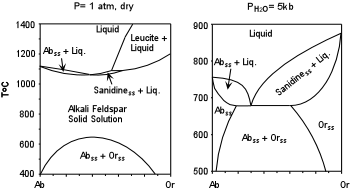 |
This results in the crystallization of two alkali feldspar solid solutions, one rich in
Ab, and the rich in Or. Each of these will further exsolve on cooling to form
perthites. Granites that crystallize under these conditions are referred to as subsolvus
granites. |
|
Mesozoic or younger examples of I-type granites are found along continental margins such as the Sierra Nevada batholith of California and Nevada, and the Idaho batholith of Montana. In these regions the plutonism may have been related to active subduction beneath the western U.S. during the Meszoic. I-type granites are also found in the Himalayas, which are related to continent-continent collisions. Plutonic suites that were emplaced in convergent continental margin settings, show many of the same characteristics as the calc-alkaline volcanic suite that likely erupted on the surface above. The suites include gabbros, diorites, quartz monzonites, granodiorites, and granites. They show mild to no Fe-enrichment, similar to calc-alkaline volcanic rocks, and a range of isotopic compositions similar to the associated volcanic rocks. Nearly all are I-type granitoids. An example of the a convergent margin plutonic suite is found in the Sierra Nevada
Batholith and associated plutons in eastern California and western
Nevada that were emplaced during the Mesozoic Era. |
Exposed rocks are generally older toward the east and southeast. Kistler and Peterman showed that the Sr isotopic ratios vary across the batholith in a systematic way. The younger rocks in the western portion of the batholith are mostly quartz diorites with Sr isotopic ratios less than 0.704, ratios expected from melting of the mantle or young crustal rocks. Plutons farther east are mostly quartz monzonites and granodiorites with ratios increasing along with age of the plutons toward the east and southeast. One interpretation of the data is that the older rocks contain a higher proportion of older crustal material than the younger plutonic bodies. |
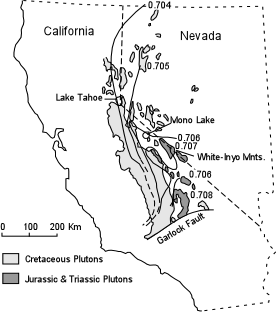 |
|
| Before considering the origin of granitic magmas we will first discuss the related rocks, the pegmatites, then consider continental rhyolites, which are likely closely related to granitic plutons. |
Pegmatites Pegmatites are very coarse grained felsic rocks that occur as dikes or pod-like segregations both within granitic plutons and intruded into the surrounding country rock. They appear to form during the late stages of crystallization which leaves H2O-rich fluids that readily dissolve high concentrations of alkalies and silica. Thus, most pegmatites are similar to granites and contain the minerals alkali feldspar and quartz. But other chemical constituents that become concentrated in the residual liquid, like B, Be, and Li, are sometimes enriched pegmatites. This leads to crystallization of minerals that are somewhat more rare, such as tourmaline, [(Na,Ca)(Mg,Fe,Mn,Li,Al)3(Al,Fe+3)6Si6O18(BO3)2(OH)4], beryl [Be3Al2Si6O18], lepidolite [K2(Li,Al)5-6Si6-7Al2-1(OH,F)4, and spodumene [LiAl2Si2O6], which are sometimes found. |
Continental Rhyolites Rhyolites are much more common and voluminous on the continents than in the ocean basins. They range from small domes and lava flows to much larger centers that have erupted volumes measured in 100s of km3. Most of the preserved volume is represented as pyroclastic flow deposits, often termed "ash flow tuffs" or "ignimbrites. Large quantities of these deposits were erupted during the middle Tertiary in the western United States, northern Mexico, throughout Central America, and on the western slopes of the Andes mountains. The composition of these deposits is usually metaluminous although peralkaline varieties are known. None are peraluminous in composition. Although the recent examples occur near continental margins. Most seem to be associated with episodes of continental extension, such as in Basin and Range Province of the Western U.S. and Mexico. |
| Three Late Tertiary examples are notable. All have formed large calderas associated with the emplacement of pyroclastic flow deposits as well as fall deposits. These include Yellowstone Caldera in Wyoming, Long Valley Caldera in eastern California, and Valles Caldera in New Mexico. Note that all three are located on the margins of the Basin and Range Province. Pyroclastic fall deposits are widespread, although not well-preserved, as would be expected. Ash from the youngest eruptions from Yellowstone occur in sediment cores from the Gulf of Mexico. Ash from Long Valley caldera is found as far east as Nebraska. Eruptions of volumes of ash similar to these would certainly be devastating to any country in which the occurred. |
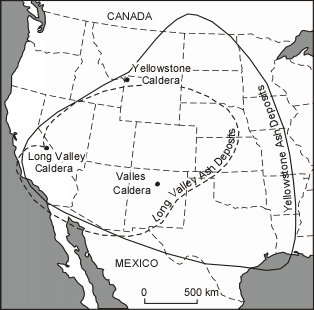 |
| As stated above, most of the preserved rocks from these large silicic systems are preserved as pyroclastic flow deposits that spread out close to the eruptive vents. Most display various degrees of welding that results from compaction and annealing of the glassy fine-grained ash particles contained in the deposits. It is the welded portions of the pyroclastic flow deposits that have the greatest potential for preservation in the geologic record, as they are more resistant to erosion. |
| Non-welded pyroclastic flow deposits are usually poorly sorted and poorly indurated. They contain blocks and lapilli-sized fragments of pumice and lithic fragments in a matrix of fine-grained glassy ash particles. | 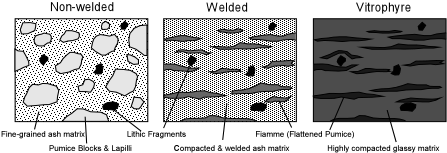 |
| Deeper in the deposit heat remains available for longer times and the weight of the
overlying material tends to start the welding process. Lumps of pumice become
compressed into disc-like forms called fiamme. The
original vesicular texture is lost and the flattened pumice loses its vesicular character.
The glassy ash particles in the matrix start to weld together, while the brittle
lithic fragments are usually not compressed. If temperature remains high and the
lower parts of the deposit are under a high load, welding may progress to turn the rock
into a vitrophyre, wherein the ash matrix becomes a coherent glass, the fiamme are
further flattened and the vesicles and pore space are completely pressed out.
Two examples of
continental rhyolite complexes will be discussed. |
|
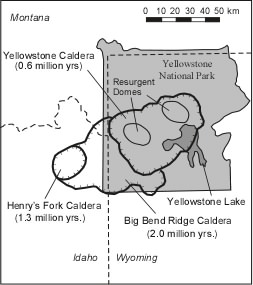 |
|
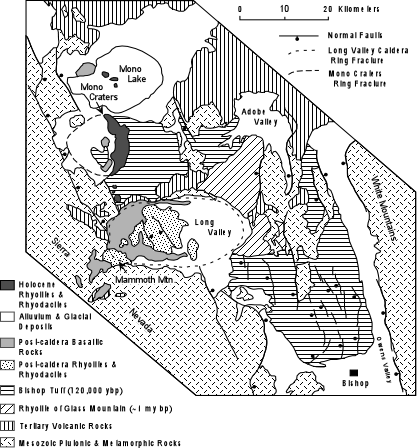 |
720,000 years ago an eruption produced about 600 km3 of pyroclastic
material, both as fall deposits and pyroclastic flows. The pyroclastic flows, known as the
Bishop Tuff, are still preserved in Owens Valley to south, and in the Mono Basin to the
north. Some flows crested the Sierra Nevada and reached the San Joaquin valley to
the west. This eruption resulted in the collapse of the area above the magma chamber
to produce Long Valley Caldera. The Bishop Tuff shows chemical zonation, having SiO2
concentrations of 77.4% in lower, first erupted units and 75.5% SiO2 in the
upper, later erupted units. This likely reflects chemical zonation in the magma
chamber. Rhyolite domes and lava flows were then emplaced on the floor of the
caldera between 0.73 and 0.61 my ago. During this time the central part of the
caldera floor was uplifted to form a structural dome, called a resurgent dome, likely due
to re-intrusion of magma below. The resurgent dome shows a central graben on the map
above. Rhyolite and rhyodacite domes and flows were also emplaced in the moat around
the resurgent dome and along the ring fractures of the caldera between 0.5 my and 0.1 my
ago. One of these, Mammoth Mountain, located on the southwestern margin of the
caldera, is now a popular ski resort. Between 0.2 and 0.06 my ago basaltic lavas were
erupted on the floor of the caldera and in areas to west of the caldera.
|
Origin of Large Volumes of Silicic Magma In the early part of the century a debate among igneous petrologists ensued concerning the origin of granitic rocks (known as the "Granite Controversy"). One group referred to themselves as the granitizationists and argued that granitic rocks were produced by ultrametamorphism at high temperatures and pressures in the Earth's crust. The other group, referred to as the magmatists, argued that granites were produced by melting and intruded as liquids into higher levels of the crust. The granitizationists used evidence mainly based on what are now recognized as catazonal plutons to make their case. They further argued that making room for such large bodies of magma in the brittle crust would be near impossible and that production of granites in place by granitization of the pre-existing rock would do away with this "room problem". The magmatists argued their case using evidence from mostly mesozonal and epizonal plutons, which clearly show evidence of the intrusive origin of these bodies and evidence that they were liquid when emplaced. Clearly there are several ways that granitic rocks could be produced, but it is highly unlikely that all granitic rocks were formed by granitization, although some catazonal bodies could have been. The fact that contact relations clearly show that many granites were liquid upon intrusion and the fact that large volumes of silicic magma actually erupt in continental rhyolite centers is plentiful evidence for the existence of liquids with granitic composition. The "room problem" argued by the granitizationists is largely solved when we recognize that most intrusive events occur during stages of deformation wherein the stress regime changes from one of compression to extension. Extension of the brittle crust can make the space into which magmas intrude. Nevertheless, it is highly unlikely that large volumes of granitic magma can be produced by crystal fractionation of basaltic magmas. Such crystal fractionation would require initial volumes of basalt 10 to 100 times greater than the siliceous liquids produced. There is no evidence for the existence of such large bodies of crystallized basalt magma in the crust. Among the mechanisms by which large volumes of granitic magma could be produced are:
|
Continental Flood Basalts Like the large submarine plateaus discussed in our lecture on the ocean basins, large volumes of basaltic magma have erupted on the continents at various times in Earth history. The most recent of these outpourings, but by no means the largest, is the Columbia River basalts erupted in Oregon and Washington states in the mid-Miocene. Other important flood basalt provinces are listed in the Table below. |
Province |
Age |
Original Area Covered (km2) | Types of Basalts % |
||
| Qtz -Thol. | Oliv. Thol. | Alk. Bas. | |||
| Lake Superior | Precambrian | 125,000 | 42 | 51 | 7 |
| Siberia | Permo-Triassic | 2,500,000 | 28 | 69 | 3 |
| Karoo, S. Africa | Jurassic | 2,000,000 | 57 | 37 | 6 |
| Paraná, Brazil | Cretaceous | 2,000,000 | 72 | 28 | 0 |
| Deccan, India | Eocene | 500,000 | 55 | 35 | 10 |
| Columbia River | Mid-Miocene | 163,000 | 30 | 70 | - |
Chemical Composition Although each flood basalt province differs somewhat in the composition of magmas erupted, most provinces have erupted tholeiitic basalts. With the exception of a few early erupted picrites in some provinces, the tholeiitic basalts tend to have lower concentrations of MgO (5 - 8%) than would be expected from melts that have come directly from the mantle without having suffered crystal fractionation. Thus, despite their large volume, they are differentiated magmas that are similar in many respects to MORBs. Still, they show incompatible trace element concentrations more similar to EMORBs, and have 86Sr/87Sr and 143Nd/144Nd ratios that extend from the OIB field toward and overlapping with continental crust. This latter feature indicates that they have likely suffered some crustal contamination. |
| Example The Columbia River Basalts represent a series of lava flows all erupted between 17 and 8 million years ago, with the bulk of the volume being erupted between 16.5 and 14 million years ago. One of the basalt flows, the Roza flow, was erupted over a period of a few weeks traveled about 300 km and has a volume of about 1500 km3. Vents for the eruptions are thought to be a series of dikes located in southwestern Washington. Despite the fact that these lavas appear to be fractionated, they are poor in phenocrysts, and individual flows are very homogeneous in composition. Furthermore, it is difficult to reconcile chemical variation among the various flows to be the result of crystal fractionation processes. Thus, the origin of the Columbia River basalts, as well as most other flood basalts, remains one of petrology's great unsolved problems. |
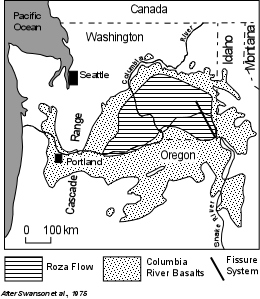 |
Continental Rift Valleys Continental Rift valleys are linear zones of extension within continental crust. Some of these extensional zones may eventually become zones along which the continents break apart to form a new ocean basin, however, there are many examples where such break-ups have failed. Among the ancient and modern examples are:
|
|
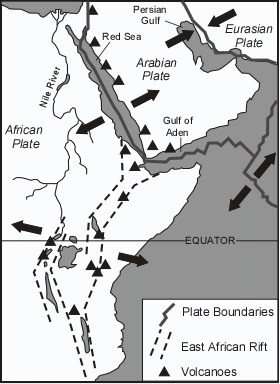 |
| Evolution of Alkaline Rock Suites The alkaline rock series found in many rifting areas are very unusual, and far less common than the basalt - andesite - dacite suites found in other environments. We here discuss how some of these unusual magmas might have come into existence. We have already discussed how low degrees of partial melting of the mantle at higher pressure can produce silica-undersaturated basaltic magmas, while increasing degrees of melting, or melting at lower pressure tends to produce silica-saturated to oversaturated basaltic magmas. Once such magmas have evolved to the point where they begin to crystallize alkali feldspar, we can see what would happen by looking at the simple three component system Ne-SiO2-Ks (kalsilite). Note that in this system, the join Ab -Or forms a partial thermal divide at low pressure, and separates Silica oversaturated compositions from silica undersaturated compositions. |
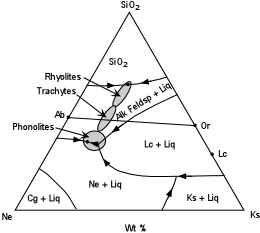 |
This is further illustrated by looking at a total alkalies versus SiO2
diagram, showing the approximate compositions of various alkaline rock types. |
| Also shown is the approximate position of the critical plane of silica-undersaturation. Note how a slightly silica-saturated basalt will evolve through hawaiites, mugearites, benmoreites and trachytes that will eventually continue to produce rhyolites. While a slightly silica-undersaturated composition will follow a similar path, but eventually produce phonolites with decreasing SiO2. |
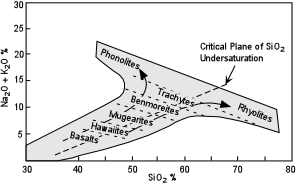 |
| Note how small amounts of crustal contamination of silica-undersaturated basalts could
also cause these silica-undersaturated magmas to become silica-saturated, and result in
the bifurcation of the trends. Thus, upwelling of the mantle beneath the
continental rift zones likely results in various degrees of melting of the mantle by
decompression melting. The presence of continental crust, favors small amounts of
contamination of these already alkali rich magmas resulting in the production of
basalt-trachyte-rhyolite suites. Basaltic magmas that reach low pressure and are
still silica-undersaturated results in basalt-trachyte-phonolite suites. Only small
changes in composition of the original mantle-derived magmas are necessary to produce
these diverging magma types. One answer could come from fractional crystallization of plagioclase. Ca-rich plagioclase contains twice as much Alumina as the alkali feldspars, and very little alkalies. |
| Thus removal of Ca-rich plagioclase will result in depletion of Al and enrichment of Na and K (as well as Si). This is termed the "plagioclase effect". (Recall that peralkaline rocks are those that have a molecular amount of Na2O + K2O > Al2O3). On the other hand, if a ferromagnesium phase with high Ca, but little Al, such as augite, also fractionates, then Al depletion will be minimized with increasing Si, thus offsetting the plagiocalse effect to produce normal metaluminous rhyolites. | 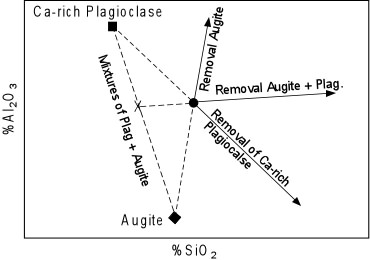 |
Examples of questions on this material that could be asked on an exam
|